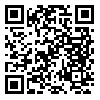Volume 4, Issue 1 (2013)
LRR 2013, 4(1): 89-104 |
Back to browse issues page
Associate Professor, Department of French Language and Literature Shahid Beheshti University, Tehran, Iran
Abstract: (5809 Views)
The purpose of this article is the comparative analysis of correlation of plot between two narrative stories: “The Prayer Dealer” (narrated in One Thousand and One Night), and “The Cittern” by Jalal A. Ahmad. We believe that the narration of “The Cittern”, from figurative point of view, is very similar to “The Prayer Dealer”. However, there is an element or word in “The Cittern” that has created a conflict in narrative coordination from plot point of view. We try to know what this element is. This question is the result of a comparative analysis between these two narrations. Analyzing the two narrations, we have found a question that was constantly preoccupying the author’s mind: “Why, in “The Prayer Dealer”, there is internal solidarity and harmony among the figures? In addition, why in “The Cittern”, we witness a conflict in the internal narrative structure and there is no such solidarity as the first one? Here is the theory based on which the author is going to answer this question: In the story of “The Prayer Dealer”, the narrative operant, “Namaz Forush” (the prayer dealer) uses his own imagination to see through the future. However, the narrative operant of “The Cittern”, a young musician goes back to his past to find answers. In the first case, seeing through the future puts the narrative plot in a very solid position, but going back to the past puts the operant in the terminal part of the narration (but the plot has lost this character in “The Cittern”). This terminal position is a potentially destructive power for a new narration. That is why the plot for “The Cittern” is not a complete one and only shows a minimal narration.
Keywords: Narration, Plot, Destructive power, Instructive power, First part, Middle part, Dissimilar worlds
Published: 2012/06/20
| Rights and permissions | |
 |
This work is licensed under a Creative Commons Attribution-NonCommercial 4.0 International License. |

